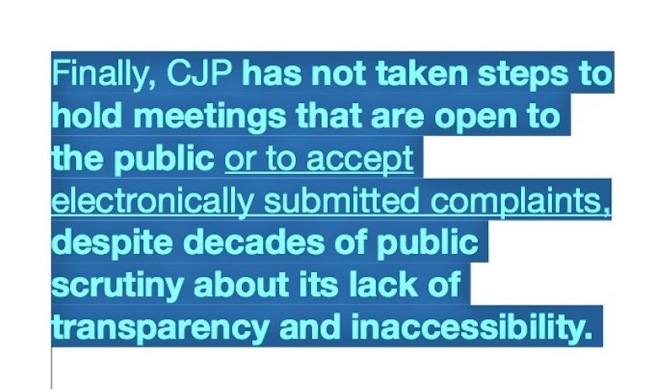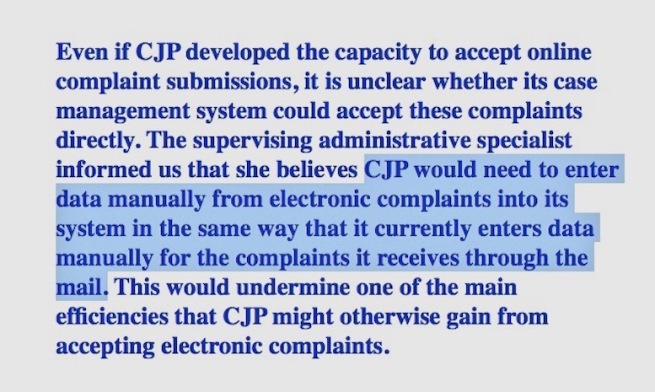

…
Transparency and a wholesale, top-to-bottom restructuring are the chief recommendations for California’s Commission on Judicial Performance (CJP) by Elaine Howle, the state’s Auditor — in her 25 April report card that adds up to a big red ‘F’ for fail. Because the CJP acquired a new director at a late stage of the audit, in 2017, there is some hope of remedial action and reform, but the historical record shows that judges excel at evading public control.
The five-year audit of the way the CJP treats complaints about judges not behaving or doing their work as judges should revealed — among other things — that:
- From 2013-14 to 2017-18, the CJP ‘closed at intake about 85 per cent of the almost 6,000 complaints it closed.’ This means that they were tossed out without investigation.
- The CJP’s complaint-investigators failed to delve adequately into about a third of the cases that the Auditor examined in detail, ‘even though these investigations involved serious allegations.’
- California judges shield each other from censure and discipline. Though California voters passed a proposition twenty-five years ago that was designed to make this harder, by ‘increasing the public’s involvement with judicial discipline,’ the CJP still hands the task of hearing evidence of judicial misconduct to members of the same tribe, ‘a panel of three judges — known as special masters.’
No summary on this site or anywhere else could be an adequate substitute for reading the Auditor’s crisp presentation of her findings, which — despite the unavoidably bloodless officialese — is liable to make a reader’s skin creep.
For instance, in the section about the CJP’s failure to look for patterns in following up on reports of misbehaving judges, the report highlights the case of the Commission receiving twelve complaints in less than ten years ‘about the demeanour and bias’ of a particular judge. In reviewing the fifth of those complaints — that the judge ‘had displayed poor demeanour and and showed favouritism during a court proceeding’ — the CJP’s investigator interviewed only the complainant and a single witness before he decided that the allegations could not be proved. The CJP ‘closed the complaint without issuing discipline.’ Worse, this CJP complaint-investigator agreed that ‘he could have expanded the scope of the review,’ which would have made it possible for him ‘to determine whether a systemic problem with the judge’s behaviour existed.’ But he told the Auditor’s team that he could not remember why he did not take that obvious step — yet was still certain that he was not guilty of any lapse in diligence.
Most astounding of all — given that the CJP’s office is in San Francisco, at the northern limit of Silicon Valley — the computer system that this body uses to manage cases is nearly 25 years old, and therefore incapable of accepting electronic submissions of allegations against judges by lawyers and litigants. The IT expert who created it for the Commission retired in 2014 without leaving ‘any written instructions for operating and maintaining the system.’
Gently castigating the CJP for its failure to update its tools — and restricting communications from complainants to snail mail — the Auditor noted that if the Commission were to accept digital submissions, its vintage case management system would require its staff to enter these into it manually, keystroke by keystroke. The result? ‘[A]s long as it relies on its outdated system, CJP will be significantly hindered from increasing its accessibility to the public.’
In whose interests could it be to under-equip the CJP so woefully? Powerful people with sharp brains bent on ensuring that the Commission is only barely capable of executing the tasks for which taxpayers pay it handsomely.
Impressively, the Auditor’s report was released with the CJP’s response to a final draft of it — and Elaine Howle’s reply to that reaction (on the same web page). Their bristly exchange prefigures the colossal struggle on the horizon between representatives of the public interest and the California judiciary. If the past is any guide, the judges will win — succeed in ensuring that the CJP remains virtually toothless — even if the Auditor’s office gets the support it needs from legislators in Sacramento. The comprehensive structural overhaul Elaine Howle recommends for the CJP cannot happen without an amendment to the state’s constitution. That can only be accomplished by vote, in the legislature.
Answering the CJP’s claim that it had ‘fully cooperated with the audit,’ the Auditor made it clear that the Commission had only done so after crippling this review for nearly two years by initiating a legal action intended to obstruct or kill it. Of course the CJP does not believe that it needs reorganisation, or that the Auditor was right to conclude that its present, ‘unitary’ structure is problematic, even though this means that the same group of people conducts investigations into charges of judges doing their jobs poorly and decides whether or not they deserve punishment, and by what means. With extraordinary tact, the Auditor refrained from spelling out what makes that grouping-together undesirable. It is essentially this: that it makes it too easy to shield bad judges from chastisement by conveniently failing to discover evidence to support charges against them; or by declining to look for it at all.
Rejecting the Commission’s argument that ‘the California Supreme Court has consistently upheld the unitary structure of CJP as a judicial discipline agency,’ the Auditor pointed out that ’17 states have adopted a bicameral structure for their judicial oversight commissions,’ and that ‘the American Bar Association’s model rules for judicial disciplinary enforcement’ prescribe precisely such a form of organisation ‘that separates investigating and adjudicative functions.’
The CJP did agree to improve its transparency and modernise its antiquated operations without making any specific commitments, such as whether it would or would not be following the recommendations that it hold meetings open to the public and enable electronic submissions by complainants.
Ominously, though, it warned that ‘[t]here has never been a successful challenge to CJP’s structure and authority,’ — a history which, it claimed, ‘establishes that there is no problem …’.
…
The California judiciary is highly skilled at batting away demands for reform by voters and legislators, and at neutralising legal statutes imposing new rules for its functioning.
Anyone interested in this record need look no further than a topic that this site has touched on before — so-called ‘unpublished’ opinions, or rationales for decisions by courts of appeal. An appellate opinion explains exactly how a panel of judges arrived at their decision and chose to apply the relevant law, in determining the fate of an appeal against a lower court’s judgment.
But because too many judges would rather not take responsibility for any of that, branches of the U.S. judiciary have for decades insisted on labelling as ‘unpublished’ the texts of too many appellate opinions that are, in fact, widely circulated, and accessible anywhere on the internet, at no charge, almost immediately after they are issued. The designation has crucial implications . Among these is that it more or less absolves loftier courts of the responsibility to vet them — effectively insulating lower-ranking judges from being held accountable and punishable for what they do.
For how long have judges been using this form of deception to conceal defective or corrupt reasoning and disregard for the law they are supposed to follow? In his eye-opening historical treatise on the subject — going back to the mid-19th century, and restricted to California — Rafi Moghadam has shown how the practice is only the latest ploy for averting accountability, after the state’s judiciary could no longer dodge the task of issuing written opinions. In 1854, state lawmakers introduced new law requiring that the opinions of courts of appeal at every level be delivered in writing. The state’s highest court ‘responded by invalidating the statute,’ and ‘held that the legislature was without authority to require the judicial branch to provide written reasons for its decisions.’ Then, in 1879, ‘the voters of this state disapproved opinionless judgments …’.
Eventually, the California judiciary adopted the ruse of ‘unpublished’ opinions — a decision committed to writing, but of limited value for ensuring accountability because ‘casting doubt on the soundness of its reasoning’ without taking anyone to task for that is what its tricky labelling accomplishes.
This device is still being used in the 21st century. In her contribution to the debate — ‘Legal Fiction of the “Unpublished” Kind: The Surreal Paradox of No-Citation Rules and the Ethical Duty of Candor’ — J. Lyn Entrikin Goering noted in 2005 that ‘eighty percent of the decisions issued each year by the thirteen federal courts of appeal are designated as “unpublished” or “nonprecedential’’.’ That number has since soared to 88 per cent.**
…
Elaine Howle, the California Auditor, said in her rebuttal of the Commission’s objections to her audit: ’We look forward to reviewing evidence of how CJP implements our recommendations.’
With supernatural luck — and enough pressure from the public and valiant lobbying organisations, such as the Center for Judicial Excellence — this site might have something significant of that nature to report.
But any readers waiting for it would be ill-advised to hold their breath.
…
…
** in the twelve months to 30 September 2018, according to government statistics on U.S. courts, to which Professor Entrikin was kind enough to send COTIN a link.